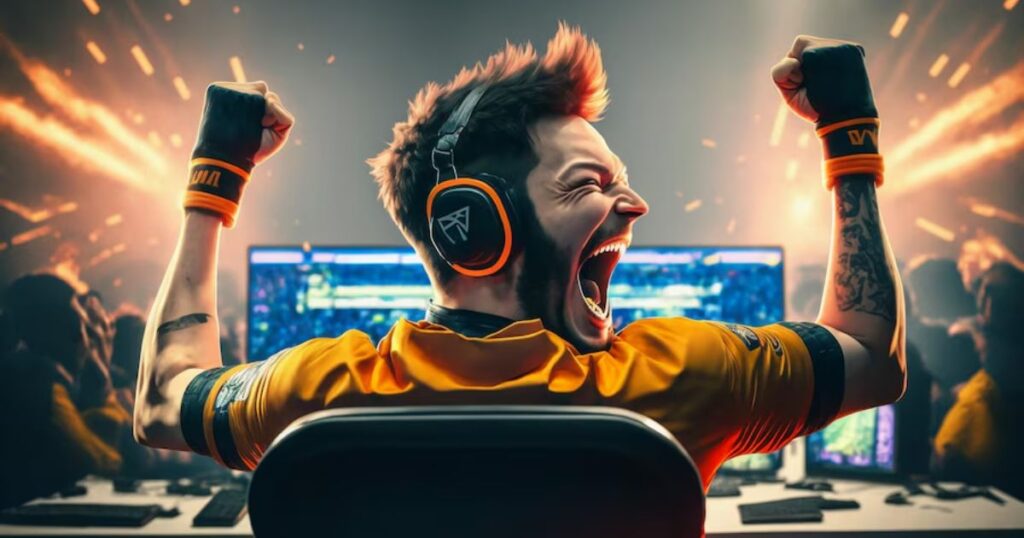A Gaming Defstartup is a new way to start a gaming company. It works fast and uses smart methods. The goal is to make new games without spending too much money or taking big risks. Gaming Defstartups focus on being quick, creative, and listening to what gamers want.
Think about turning your love for games into a real business. “Gaming Defstartup” shows you how to do well in the game world. It gives new ideas about making games and running a business. This guide will help you deal with tough competition in gaming.
Gaming Defstartups are changing how games are made. They use new tech and think differently. These startups often make games for small groups of players or try new kinds of games. This helps them make games that are different from others. Gaming Defstartups are shaping how we’ll play games in the future.
Understanding the Gaming Industry
Overview of the Gaming Market
The gaming market in the United States has exploded in recent years, with no signs of slowing down. In 2023, the U.S. gaming market is expected to reach a staggering $95 billion, a testament to the industry’s resilience and growth potential. This surge isn’t just about big-budget AAA titles; indie developers are carving out significant niches, proving that innovation and creativity can compete with deep pockets.
Major players like Electronic Arts, Activision Blizzard, and Nintendo continue to dominate, but the digital distribution revolution has leveled the playing field. Platforms like Steam, Epic Games Store, and mobile app stores have opened doors for smaller studios to reach global audiences without the need for traditional publishing deals.
Key Trends and Statistics
The gaming landscape is constantly evolving, and staying ahead of trends is crucial for any gaming Defstartup. Mobile gaming has seen explosive growth, accounting for over 50% of the global gaming market. The convenience of smartphones and tablets has created a new breed of casual gamers, expanding the potential audience for innovative game concepts.
Cloud gaming services like Google Stadia and Amazon Luna are reshaping how games are played and distributed. This technology allows players to stream high-quality games without the need for expensive hardware, potentially expanding the market for graphically intensive games.
Esports and game streaming have become cultural phenomena, with platforms like Twitch and YouTube Gaming turning gaming into a spectator sport. This trend offers new avenues for game promotion and community building, essential for any gaming Defstartup looking to make its mark.
Conceptualizing Your Gaming Defstartup
Identifying Your Niche
Finding your niche in the crowded gaming market is crucial for standing out. It’s about striking a balance between innovation and market demand. Take Stardew Valley, for example. Created by a single developer, Eric Barone, this farming simulation RPG tapped into nostalgia for games like Harvest Moon while introducing fresh mechanics and a charming art style. The result? Over 10 million copies sold across multiple platforms.
To identify your niche:
- Analyze current market gaps
- Consider your team’s strengths and passions
- Look for emerging technologies or platforms you could leverage
- Study successful indie games for inspiration
Defining Your Target Audience
Understanding your audience is key to crafting a game that resonates. Create detailed player personas that go beyond basic demographics. What are their gaming habits? What motivates them to play? Use tools like Google Analytics and social media insights to gather data on potential players.
For instance, if you’re developing a mobile puzzle game, your target audience might be:
- Age: 25-45
- Gender: Skews female (60%)
- Occupation: Professionals with busy schedules
- Gaming Habits: Plays in short bursts during commutes or breaks
- Motivations: Mental stimulation, stress relief, sense of achievement
Creating a Unique Value Proposition
Your Unique Value Proposition (UVP) is what sets your gaming Defstartup apart from the competition. It should clearly communicate why players should choose your game over others. Here’s a formula to craft a compelling UVP:
[Your Game] is a [Game Genre] that [Unique Benefit] for [Target Audience] who [Player Need].
For example: “Cosmic Crush is a space exploration RPG that combines real-time strategy with social simulation for sci-fi enthusiasts who crave deep, immersive storytelling in a scientifically accurate universe.”
Market Research and Analysis

Conducting Competitor Analysis
Thorough competitor analysis is crucial for positioning your gaming Defstartup. Identify both direct competitors (games in the same genre) and indirect competitors (games competing for your audience’s time and money). Conduct a SWOT analysis for each major competitor:
| Competitor | Strengths | Weaknesses | Opportunities | Threats |
| Game A | Strong IP | Buggy launch | Untapped mobile market | Rising dev costs |
| Game B | Large community | Aging engine | Esports potential | New entrants |
Use this analysis to identify areas where you can outperform competitors or fill gaps in the market.
Understanding Market Needs and Gaps
To truly understand what players want, go beyond surface-level market research. Engage with gaming communities on platforms like Reddit and Discord. Analyze app store reviews of similar games to identify common complaints or desired features. Consider running surveys or focus groups to get direct feedback on your game concept.
Remember, sometimes the most significant opportunities lie in addressing needs that players don’t even realize they have. The success of games like Minecraft or Among Us demonstrates how innovative gameplay can create entirely new market segments.
Evaluating Potential Challenges and Opportunities
A PESTLE analysis can help you anticipate external factors that might impact your gaming Defstartup:
- Political: Gaming regulations, content restrictions
- Economic: Consumer spending trends, exchange rates for international markets
- Social: Changing gaming demographics, social issues in gaming
- Technological: Emerging platforms, advancements in graphics technology
- Legal: Copyright laws, data protection regulations
- Environmental: Sustainability concerns in gaming hardware
By considering these factors, you can better prepare for challenges and capitalize on opportunities as they arise.
Building Your Game Development Team
Key Roles and Responsibilities
Assembling the right team is crucial for your gaming Defstartup’s success. While roles may overlap in smaller teams, here are the key positions to consider:
- Game Designer: Responsible for core gameplay mechanics and overall player experience
- Programmers: Bring the game to life through code, specializing in areas like graphics, AI, or networking
- Artists: Create visual elements, including characters, environments, and UI
- Sound Designer: Develops music and sound effects to enhance immersion
- Writer: Crafts narrative and dialogue (if applicable to your game)
- QA Tester: Ensures game quality and identifies bugs
- Project Manager: Keeps development on track and within budget
Hiring Strategies for Top Talent
Attracting top talent to your gaming Defstartup requires creativity and networking. Attend game development conferences and local meetups to connect with potential team members. Utilize platforms like LinkedIn and specialized job boards like GameDev.net to reach a wider pool of candidates.
When hiring, look beyond just technical skills. Passion for gaming, ability to work in a startup environment, and cultural fit are equally important. Consider offering equity or profit-sharing to attract talented individuals who believe in your vision.
Fostering a Collaborative Team Culture
Creating a positive work environment is essential for creativity and productivity. Implement agile methodologies like Scrum to keep development flexible and team-focused. Encourage open communication through regular team meetings and brainstorming sessions.
Remember, game development can be intense. Prevent burnout by promoting work-life balance and celebrating team achievements, both big and small. A happy team is more likely to produce an outstanding game.
In addition to regular team meetings and brainstorming, you can also create a positive working environment and cultivate a collaborative team culture by customizing office supplies, such as Custom Lanyards.
Companies can customize the company name, company logo, corporate culture and philosophy, department name, team slogan, etc. into lanyards for hanging employee identity information cards. If your company has a specific project team, you can also customize lanyards for project team members with the name of the project team. Of course, you can also be bold and innovative and abandon the dullness of traditional corporate lanyards, such as customizing cute girlish cartoon lanyards for female employees.
Custom lanyards can not only meet office needs but also help promote corporate culture and cultivate team cohesion.
Developing Your Game

Choosing the Right Game Engine
Selecting the appropriate game engine is a crucial decision that will impact your entire development process. Popular choices include Unity, Unreal Engine, and Godot, each with its own strengths:
- Unity: Known for its versatility and large asset store. Ideal for mobile and indie games.
- Unreal Engine: Offers stunning graphics and is favored for high-end 3D games.
- Godot: Open-source and lightweight, great for 2D games and beginners.
Consider factors like your team’s expertise, target platforms, and specific game requirements when making your choice. Remember, the best engine is the one that allows you to bring your vision to life efficiently.
Importance of Prototyping
Prototyping is an essential step in game development that allows you to test core mechanics before committing to full-scale production. Start with paper prototypes to test basic concepts, then move to digital prototypes to refine gameplay elements.
Early prototyping can save you time and resources by identifying potential issues early. It also provides tangible demos to show potential investors or team members, helping to build excitement and buy-in for your project.
Iterative Development Process
Embrace an iterative development approach to continuously improve your game. Break development into sprints, focusing on specific features or levels in each cycle. After each sprint, playtest and gather feedback to inform the next iteration.
This approach allows for greater flexibility and helps ensure that your final product aligns with player expectations. Remember, some of the most successful games evolved significantly during development based on player feedback.
Testing and Quality Assurance
Thorough testing is crucial for delivering a polished game that players will love. Consider using both in-house testers and beta testers from your target audience to get a wide range of feedback.
Automated testing tools can also help catch issues early in the development process. Implement a comprehensive QA process that includes:
- Functional testing to identify bugs and glitches
- Performance testing across different devices and platforms
- Usability testing to ensure intuitive gameplay
- Compatibility testing with various hardware configurations
- Localization testing for international markets
Funding Your Gaming Defstartup
Bootstrapping vs. Seeking Investors
Deciding between self-funding and seeking external investment is a crucial choice for your gaming Defstartup. Bootstrapping allows for greater creative control and keeps you debt-free, but it may limit your resources and slow down development. On the other hand, external investment can provide the capital needed for faster growth and marketing, but it often comes with expectations of rapid returns and potential loss of control.
Consider your game’s scope, timeline, and financial needs when making this decision. Some successful indie games like Stardew Valley were entirely self-funded, while others like Psychonauts 2 relied on a mix of crowdfunding and publisher support.
Types of Funding Options
Explore various funding avenues to find the best fit for your gaming Defstartup:
- Angel investors: High-net-worth individuals who invest in early-stage startups
- Venture capital: Firms that invest larger amounts in exchange for equity
- Crowdfunding: Platforms like Kickstarter or Fig that allow fans to support your project
- Publisher funding: Traditional game publishers who provide funding in exchange for distribution rights
- Government grants: Some countries offer grants or tax incentives for game development
- Game developer funds: Programs like Epic MegaGrants or Unity’s DevFund that support indie developers
Crafting a Compelling Pitch for Investors
When seeking investment, your pitch needs to stand out. Create a compelling pitch deck that includes:
- Your game’s unique value proposition
- Market analysis and target audience
- Prototype or demo footage
- Team bios highlighting relevant experience
- Financial projections and use of funds
- Marketing and distribution strategy
Practice your pitch relentlessly and be prepared to answer tough questions about your business model, scalability, and competitive advantage. Remember, investors are not just buying into your game; they’re investing in you and your team’s ability to execute your vision.
Creating a Strong Brand Identity
Developing a Memorable Game Name
Your game’s name is often the first thing potential players will encounter, so make it count. Brainstorm names that are:
- Memorable and easy to pronounce
- Relevant to your game’s theme or mechanics
- Unique within the gaming industry
- Available as a domain name and social media handles
Once you have a shortlist, test it with potential players and check for trademark conflicts. A great name can significantly boost your marketing efforts and player recognition.
Designing an Eye-Catching Logo
Your logo is the visual cornerstone of your brand. Work with a skilled graphic designer to create a logo that:
- Captures the essence of your game
- Is recognizable at different sizes (think app icons to billboards)
- Works well in color and black and white
- Aligns with your target audience’s preferences
Consider how your logo will look across different platforms and marketing materials. A versatile, memorable logo can become a powerful asset for your gaming Defstartup.
Crafting a Consistent Brand Message
Develop a clear brand voice and message that resonates with your target audience. Ensure that this brand message is consistently applied across all touchpoints, from your website to social media posts to in-game text. Consistency builds trust and helps players connect with your brand on a deeper level. This includes:
- Your game’s tagline or slogan
- Key messaging points about your game’s uniqueness
- Tone and style guide for all communications
Marketing and Promoting Your Game

Building a Pre-Launch Hype
Creating buzz before your game launches is crucial for initial success. Start by:
- Releasing a captivating game trailer that showcases your unique features
- Maintaining a dev blog or vlog series to give behind-the-scenes insights
- Participating in gaming conventions or online events to showcase your game
- Offering exclusive beta access or demos to build a core community
Utilizing Social Media and Influencers
Social media is a powerful tool for connecting with your audience. Choose platforms that align with your target demographic and create engaging content that showcases your game’s personality. Consider:
- Sharing development updates and teasers on Twitter
- Creating eye-catching gameplay clips for TikTok or Instagram
- Building a community on Discord for direct player interaction
Collaborating with gaming influencers and streamers can significantly boost your visibility. Look for content creators whose audience aligns with your target players and offer them early access or exclusive content in exchange for honest reviews or gameplay videos.
Leveraging Gaming Communities and Forums
Engage with potential players where they already gather. Participate in relevant subreddits, Discord servers, and gaming forums. Share insights, answer questions, and gather feedback. This grassroots approach can help build a loyal following and provide valuable insights for game improvements. By emphasizing community features, you can foster deeper connections and ensure the game resonates with its audience, ultimately building a loyal following and providing valuable insights.
Running Effective Ad Campaigns
While organic reach is valuable, paid advertising can help accelerate your game’s visibility. Consider:
- Targeted ads on social media platforms
- Google Ads for search visibility
- In-game advertising in other popular games
- Retargeting campaigns to reach users who’ve shown interest
Track your ad performance closely and be prepared to adjust your strategy based on what resonates best with your audience.
Launch Strategies
Planning Your Launch Timeline
A well-planned launch can make or break your gaming Defstartup. Create a comprehensive timeline that includes:
- Final round of beta testing and bug fixes
- Submission to app stores or distribution platforms
- Press kit and review copy distribution to media outlets
- Coordinated social media campaign
- Launch day events or livestreams
Be prepared for last-minute issues and have a contingency plan in place. Remember, a smooth launch can generate positive reviews and word-of-mouth promotion.
Choosing the Right Platforms for Launch
Selecting the right platforms for your initial launch is crucial. Consider:
- Your target audience’s preferred gaming platforms
- Technical requirements and development costs for each platform
- Revenue potential and competition on different stores
While a multi-platform launch can maximize reach, it also increases complexity. Sometimes, starting with a single platform and expanding later can be a more manageable approach for a new gaming Defstartup.
Engaging with Your Audience During the Launch
Launch day is your moment to shine. Engage with your audience through:
- Live streaming sessions showcasing gameplay
- Q&A sessions with the development team
- Real-time support for any launch day issues
- Encouraging and resharing player content and reviews
Be prepared to respond quickly to feedback and address any unexpected issues. Your responsiveness during this critical period can turn early adopters into loyal fans and advocates for your game.
Post-Launch Support and Updates
Importance of Customer Feedback
Once your game is live, listening to your players becomes more crucial than ever. Set up clear channels for feedback, such as:
- In-game feedback forms
- Dedicated support email
- Active social media monitoring
- Community forums or Discord servers
Analyze this feedback carefully to identify common issues, desired features, and areas for improvement. Regularly communicate with your community about how their feedback is shaping the game’s evolution.
Regular Updates and Patches
Maintaining a steady stream of updates keeps your game fresh and players engaged. Plan for:
- Regular bug fix patches to address any issues quickly
- Balance updates to refine gameplay mechanics
- New content additions to keep the game exciting
Communicate your update schedule clearly to players and consider involving the community in prioritizing new features or content.
Expanding Your Game with New Content
Long-term success often depends on how well you can keep players coming back. Consider:
- Developing DLC or expansion packs to extend the core game
- Introducing seasonal events or limited-time content
- Collaborating with other games or brands for crossover content
Each new addition should align with your game’s core appeal while offering something fresh and exciting to your players.
Monetization Strategies
Free-to-Play vs. Paid Games
Choosing the right monetization model is crucial for your gaming Defstartup’s financial success. Consider:
Free-to-Play (F2P):
- Pros: Larger potential player base, ongoing revenue stream
- Cons: Higher user acquisition costs, need for continuous content updates
Paid (Premium):
- Pros: Upfront revenue, potentially higher perceived value
- Cons: Smaller initial player base, pressure for a strong launch
Your choice should align with your game type, target audience, and long-term business goals. Some games, like Fortnite, have found massive success with F2P models, while others, like Stardew Valley, have thrived as premium titles.
In-Game Purchases and Microtransactions
If you opt for a F2P model or want to supplement a paid game, in-game purchases can be a powerful revenue stream. Consider offering:
- Cosmetic items (skins, emotes, etc.)
- Time-savers or boosters
- Exclusive characters or abilities
- Battle passes or season passes
The key is to ensure these purchases enhance the player experience without creating a “pay-to-win” environment that alienates free players. Strike a balance between enticing purchases and maintaining fair gameplay.
Subscription Models
Subscription models are gaining traction in the gaming industry, offering a steady revenue stream and encouraging long-term player engagement. You might consider:
- Access to a rotating catalog of games (like Xbox Game Pass)
- Premium features or content for your game
- Early access to new content or updates
Ensure your subscription offers clear value to players, perhaps combining it with other monetization methods for maximum flexibility.
Legal Considerations
Intellectual Property Protection
Protecting your gaming Defstartup’s intellectual property (IP) is crucial. Take steps to secure:
- Copyrights for your game’s code, art, and music
- Trademarks for your game name and logo
- Patents for unique game mechanics or technologies (if applicable)
Consider consulting with an IP lawyer to ensure comprehensive protection. Remember, your game’s IP can become a valuable asset, potentially leading to merchandising opportunities or franchise expansions.
Compliance with Gaming Regulations
Navigate the complex landscape of gaming regulations to avoid legal pitfalls:
- Obtain appropriate age ratings (ESRB, PEGI, etc.) for your target markets
- Comply with loot box regulations, which vary by country
- Adhere to advertising standards, especially for games marketed to children
- Ensure compliance with gambling laws if your game includes any chance-based rewards
Stay informed about changing regulations, as the gaming industry is under increasing scrutiny from lawmakers worldwide.
Handling Player Data and Privacy
With data privacy concerns on the rise, protecting your players’ information is both a legal requirement and a trust-building measure:
- Implement robust data security measures to prevent breaches
- Clearly communicate your data collection and usage policies
- Comply with regulations like GDPR in the EU and CCPA in California
- Offer players control over their data, including the ability to delete their accounts
Building a reputation for respecting player privacy can become a competitive advantage in today’s market.
Future Growth and Scaling

Expanding Your Game Portfolio
As your gaming Defstartup gains traction, consider expanding your portfolio:
- Develop sequels or spin-offs leveraging your existing IP
- Create games in new genres to diversify your audience
- Collaborate with other developers for cross-pollination of ideas
Remember to balance resources between supporting existing games and developing new ones. Supercell, for example, has found success by maintaining a small portfolio of high-quality, long-lasting games.
Entering New Markets
Global expansion can significantly boost your gaming Defstartup’s growth:
- Localize your game for different languages and cultures
- Partner with local publishers to navigate new markets
- Adapt your marketing strategies for regional preferences
- Consider cloud gaming platforms to reach players without high-end hardware
Research each new market thoroughly, as gaming preferences and regulations can vary widely between countries.
Building a Sustainable Business Model
Long-term success in the gaming industry requires adaptability and foresight:
- Diversify revenue streams beyond game sales (e.g., merchandise, licensing)
- Invest in player retention strategies to maintain a stable user base
- Stay ahead of technological trends (VR, AR, cloud gaming)
- Foster a company culture that attracts and retains top talent
Remember, the most successful gaming companies are those that can evolve with the industry while staying true to their core vision.
Read More:
FAQs
What are the biggest challenges in starting a gaming Defstartup?
The biggest challenges in starting a gaming Defstartup are securing funding and standing out in a crowded market. Developing innovative games while managing limited resources and attracting a dedicated player base are also major hurdles.
How much does it cost to develop a game?
The cost of developing a game varies widely. It can range from a few thousand dollars for a simple mobile game to over $100 million for a major console or PC title.
How long does it take to launch a game?
Launching a game can take anywhere from a few months to several years. The timeline depends on the game’s complexity, team size, and resources available.
What skills are essential for a game development team?
Essential skills for a game development team include programming, art and design, and project management. The team also needs expertise in game engines, 3D modeling, animation, and sound design.
How can I attract investors to my gaming Defstartup?
To attract investors to your gaming Defstartup:
- Create a strong business plan and prototype to showcase your game’s potential.
- Network at gaming industry events and pitch your unique value proposition to relevant investors.
Final Thoughts
Launching a Gaming Defstartup offers an exciting opportunity to turn your passion into a thriving business. By leveraging lean methodologies and innovative approaches, you can create unique gaming experiences that stand out in a competitive market. Success requires a deep understanding of the industry, a strong team, and the ability to adapt to rapidly changing trends.
With careful planning, creative vision, and perseverance, your Gaming Defstartup can make a significant impact in the world of interactive entertainment. Remember, the journey of game development is as rewarding as the final product – embrace the challenges and let your creativity shine.

I am a web content writer with 4 years of experience. I share insights and expertise on various topics through my personal blog, “haadizone.com,” covering a wide range of global content.

